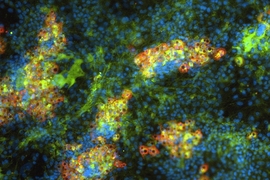"I’m mostly driven by how to fix things,” states Sangeeta Bhatia. “I’m always thinking about how to solve problems by repurposing tools.” Although not a mechanic, Bhatia, the John J. and Dorothy Wilson Professor of Health Sciences and Technology (HST), Electrical Engineering and Computer Science (EECS), and Institute for Medical Engineering and Science (IMES), does run a repair shop of sorts. As director of the Laboratory for Multiscale Regenerative Technologies, she tackles some of medicine’s most intractable problems, developing sophisticated devices and methods for diagnosing and treating human disease.
Bhatia’s research defies traditional academic categories, drawing simultaneously on biological and medical sciences, and multiple engineering disciplines. She has generated dozens of patents, several business spinouts, and earned a host of major scientific honors, including the 2014 Lemelson-MIT Prize, a $500,000 award recognizing an outstanding American midcareer inventor, and the David and Lucile Packard Fellowship, given to the nation’s most promising young professors in science and engineering.
A member of the Koch Institute for Integrative Cancer Research, her unorthodox career got an early start, thanks in part to Bhatia’s self-described passion for “tinkering.” As a child, she could fix the family’s broken answering machine, and was handy with hot glue guns “in a Martha Stewart way.” Her father, recognizing her potential as an engineer, brought her to the lab of an MIT acquaintance who was using focused ultrasound to heat up tumors. Her encounter with technology used against deadly disease proved formative.
Bhatia was determined to become a biomedical engineer, earning an undergraduate degree in the field. She came to view the human body “as a fascinating machine” whose failures she might address by designing interventions. But it was while she was simultaneously pursuing her doctorate in medical engineering at MIT and her MD at Harvard Medical School that Bhatia’s core research concerns began to crystallize.
Investigating a potential artificial organ to process the blood of patients suffering liver failure, Bhatia improvised a novel approach. Borrowing microfabrication technology from the semiconductor industry, she arrayed liver cells on a synthetic surface, and to her delight, this hybrid tissue remained alive in the lab for weeks. Scientists had long sought a way to sustain liver cells ex vivo, and Bhatia had delivered a biomedical first.
With her innovative adaptation of engineering tools for medically useful applications, Bhatia conjured a unique research methodology. And she also found her primary research subject: “I had an ‘aha’ moment, and realized I loved studying the liver.”
Diseases of the liver, unlike those of other organs, don’t have ready treatments. Severe alcohol abuse, hepatitis, and a host of other liver diseases sicken and kill millions each year. In addition, many aspects of the liver remain a mystery, including its unique tissue architecture and ability to regenerate. “It seemed like an incredible opportunity; anything you provided might have an impact,” says Bhatia.
Motivated by this opportunity, Bhatia began generating a steady stream of liver-focused bioengineering tools. For instance, she transformed her hybrid microfabricated liver tissue into a platform for screening drugs outside the body. In a current study, Bhatia is using an artificial liver as a testing ground for a drug with the potential to destroy the malaria parasite at different stages of its life cycle.
She is also closing in on the “naively audacious” goal of building a replaceable liver for patients in need of a liver transplant. Her team has identified chemical compounds that send regeneration signals to liver cells, and she is now successfully growing human livers in mice.
Bhatia has more recently aimed her biotech arsenal at targets beyond the liver. Exploiting nanoparticles, she is devising an inexpensive urine test for cancer that could prove immensely useful in the developing world. She has also begun attacking two of the deadliest cancers, ovarian and pancreatic, designing nanomaterials that can penetrate tumors with a cargo of RNA to silence spreading cancer genes.
“As an engineer, I have a hammer, and look for the next nail,” Bhatia says. “But as a physician, I also want to pick problems with the most clinical impact.”










